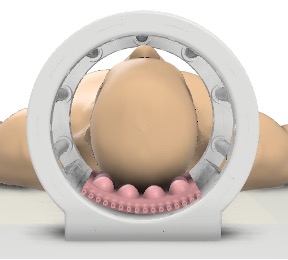Addressed Need
Head motion remains a major challenge during medical imaging scans, particularly in pediatric and older patient populations. Motion impacts diagnostic image quality, costing both time and money in the clinical setting. In research, motion artifacts can introduce errors into quantitative measurements, especially in high-resolution or low signal-to-noise scans. While current solutions rely on careful patient positioning or specialized cameras, this technology is an inexpensive alternative that improves ease-of-use and patient comfort.
Technology Description
The system is based on a soft silicone motion sensing pad that replaces the standard cushion under the subject’s head. The pad contains fluid pressure sensors that measure pressure imparted by a moving head inside the scanner in real-time, allowing head motion data to be tracked and transferred when coupled with a microprocessor. This system allows sequence-agnostic tracking of head motions in 6 degrees freedom to enhance image and data quality.
Competitive Advantages
Existing motion tracking solutions require the subject to be marked or in direct line of sight of optical cameras, or use NMR signals, light, or RF and head acceleration data for correction. This head cushion system is easy-to-use, integrates into the workflow, and improves patient comfort. Because the system works in real-time, it does not interfere with the image acquisition process. While the main application is in head MRI, this technology can be utilized across modalities, including CT and PET scanners and radiation therapy systems.

Figure: The pressure-sensing pad is placed below the patient’s head inside of the standard MRI head coil, allowing for real-time tracking of head motion and improved correction, regardless of MRI sequence or scanner.
Stage of Development
A sensing pad prototype has already demonstrated highly accurate motion tracking. Researchers have also outlined motion modeling procedures for calibration. Further experimentation is being done inside MRI scanners and on improving real-time motion correction.
Intellectual Property Status
Patent: US2024/0260853




